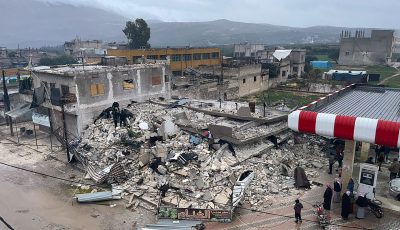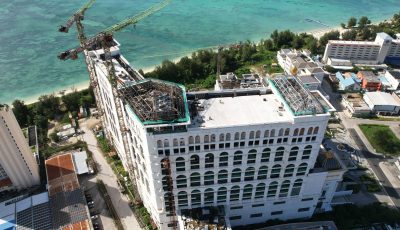Water tanks, solar panel repairs provide relief on Fais, Ulithi
YAP, Federated States of Micronesia—An extraordinary logistics challenge has brought together officials from the Secretariat of the Pacific Community, Federated States of Micronesia, and Yap State government agencies, the European Union and local residents on a remote island in the north Pacific.
Forty-seven household rainwater harvesting tanks and 70 containers filled with fresh water are progressively being shipped to the edge of a coral reef surrounding Fais Island, FSM, and then floated, or “lightered” ashore.
In the wake of Typhoon Maysak, which struck FSM four weeks ago, the assistance is not only helping the island’s residents recover, but will also have lasting benefits in enabling them to cope better with drought, changes in rainfall and extreme weather events in the future.
The 1,300 gallon (5000 liter) tanks are being provided to Fais residents as part of the SPC-implemented, European Union-financed, Global Climate Change Alliance: Pacific Small Island States project.
The head of the European Union Delegation for the Pacific, Ambassador Andrew Jacobs, and the director of SPC’s North Pacific Regional Office, Gerald Zackios, were in Fais to see the first water tanks arriving.
Along with Yap State government officials, they also inspected typhoon damage to solar photovoltaic micro-grid systems in Fais and Ulithi, which were installed by SPC in the framework of the North-REP project, and to take part in planning rapid repairs.
“It’s great to see how the European Union is making a real difference to the lives of those affected by typhoon Maysak and increasing the resilience of their communities,” Jacobs said on his first visit to Yap.
“With the expertise of SPC, and working closely with the local authorities, we are helping to provide better access to clean water and renewable electricity, and we have ensured that ongoing projects respond rapidly to new, unforeseen challenges.”
Zackios highlighted the importance of the new water tanks to local communities.
“These household water tanks will be crucial in addressing issues of health and hygiene, both in the immediate aftermath of typhoon Maysak and in the longer term,” Zackios said.
“In these low-lying outer islands, having greater water storage capacity is very important, as people are almost completely reliant on rainwater.
“The fortitude of the people of these remote islands, especially after such a devastating typhoon, is inspiring, and Ambassador Jacobs and I have been humbled by the welcome they’ve shown us during our visit to Fais and Ulithi,” Zackios added.
A technical assessment conducted at Fais, Ulithi Falalop and Ulithi Mogmog has identified the components required to restore the renewable energy power source, including replacing 210 solar modules, some electronics, 97 pieces of timber, 75 pieces of roofing iron and accessories.
Fortunately, a pump house that was erected in Fais just days before Typhoon Maysak, through the Global Climate Change Alliance project, survived intact. As part of the same project, work had been almost completed to install a solar pump and piping for an emergency well and important groundwater source for approximately 300 people on Fais.
Immediately after the typhoon, installation was completed with the help of Yap State Public Service Corporation, giving the population access to water for washing and cooking.
The director of the Yap State Resources and Development agency, Frank Haregaichig said: “I am excited because of the ongoing work that will benefit the people on this remote island but nervous about the logistical issues and distance between the island of Yap and Fais that make the 30 June planned completion date for the installation of the water tanks a challenge for us.”
“We are thankful to the EU for funding, and to SPC and the FSM Government for their substantial inputs,” Haregaichig said.
Fais community representative Jesse Salalu, said: “The well and tanks being provided mean so much to the people of Fais Island. There will be enough drinking water for the people on Fais and also enough to provide for our neighboring islands during dry seasons. It also means no more sweat for hauling water from the school’s main tank by women and children to their homes.”
The European Union also funds the Building Safety and Resilience in the Pacific program, which has components in Yap and Chuuk States, and is also implemented by SPC. Ambassador Jacobs was briefed on the Joint Action Plan for Disaster Risk Management and Climate Change developed for Yap, due to be adopted by the state government, and supported through the Building Safety and Resilience project.
The solar micro-grids, installed as part of North-REP, are expected to be fully operational again by the end of July. (SPC)



























